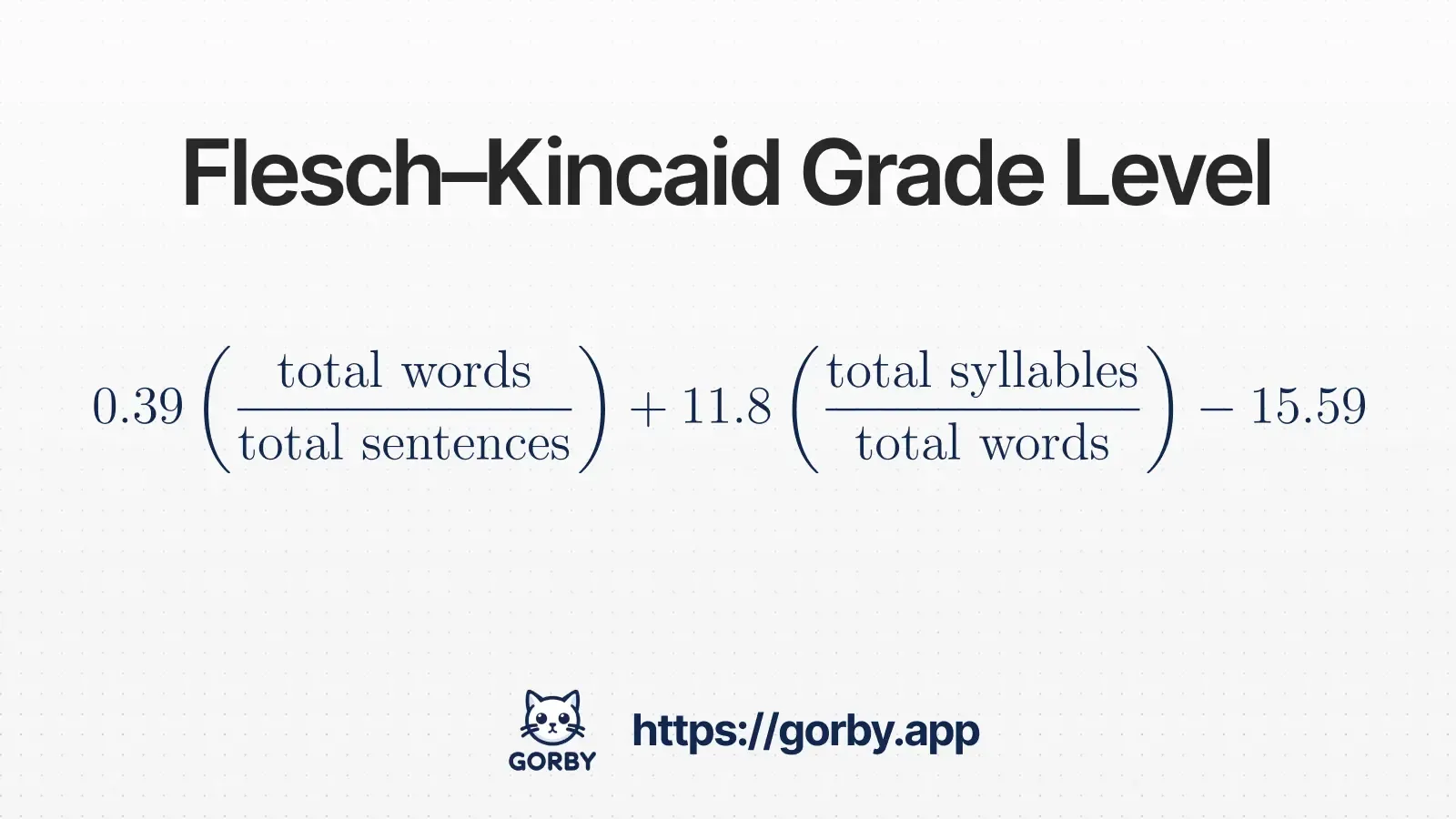Flesch-Kincaid Grade Level Calculator and Formula
Calculate your text's grade level instantly with the Flesch-Kincaid Grade Level formula. This adaptation of the Flesch Reading Ease formula converts readability measurements into equivalent U.S. grade levels, making it easy to match your content to your audience's educational background. Perfect for educators, technical writers, and content creators who need to ensure their writing meets specific reading level requirements.
Understanding the Flesch-Kincaid Grade Level

What is the Flesch-Kincaid Grade Level?
The Flesch-Kincaid Grade Level formula is a readability metric that converts text complexity into a corresponding U.S. grade level. Developed under contract to the U.S. Navy in 1975 by J. Peter Kincaid and his team, this formula adapts Rudolf Flesch's original Reading Ease score into a more directly applicable educational grade level.
Unlike the Flesch Reading Ease score with its 0-100 scale, the Flesch-Kincaid Grade Level provides a number that corresponds to a U.S. grade level, making it particularly useful for educators, technical writers, and content creators who need to match their writing to specific educational backgrounds.
Origins and Development
Building on Flesch's groundbreaking work in readability measurement, the Flesch-Kincaid Grade Level formula was first introduced in 1975. It became a United States Military Standard and was quickly adopted for assessing the difficulty of technical manuals. The formula's practical grade-level output made it particularly valuable for ensuring materials matched readers' education levels.
How it Works
The formula assesses two primary components of your text:
- Sentence Length: Measured by counting the average number of words per sentence. Longer sentences typically indicate a higher grade level.
- Word Complexity: Evaluated by counting syllables per word. More syllables per word correlate with higher grade levels.
Modern Applications
Today, the Flesch-Kincaid Grade Level formula is widely used across various fields:
- • Legal Documentation: Many U.S. states require insurance policies be written at specific grade levels
- • Educational Publishing: For matching textbooks to appropriate grade levels
- • Technical Writing: Ensuring documentation matches users' reading levels
- • Content Creation: Optimizing web content for target audiences
- • Government Communications: Making public documents more accessible
The Flesch-Kincaid Grade Level Formula Explained
Understanding the Components
The Flesch-Kincaid Grade Level formula combines sentence length and word complexity measurements with carefully calibrated weights to predict the U.S. grade level needed to understand a text. Let's break down each component:
Average Sentence Length
The first part (0.39 × words/sentences) measures syntactic complexity through average sentence length. The relatively small coefficient of 0.39 ensures that sentence length has an appropriate impact on the final grade level. Longer sentences typically indicate higher grade levels, as they often contain more complex ideas and relationships.
Word Complexity
The second part (11.8 × syllables/words) evaluates vocabulary complexity by measuring syllables per word. The larger coefficient of 11.8 indicates that word complexity has a stronger influence on the grade level than sentence length. This reflects research showing that vocabulary difficulty is a key indicator of reading level.
Grade Level Adjustment
The constant -15.59 adjusts the raw score to align with U.S. grade levels. This calibration ensures that the formula produces results that correspond meaningfully to actual grade levels in the U.S. education system.
Calculation Guidelines
- Sentences are counted based on standard end punctuation (periods, exclamation points, question marks)
- Words are counted as they appear between spaces, including numbers and abbreviations
- Syllables are counted as they would be pronounced in standard English
Interpreting Grade Levels
The Flesch-Kincaid Grade Level score directly corresponds to the U.S. education grade level required to comprehend the text. Unlike percentage-based scores, this straightforward grade-level output makes it easy to match content to your target audience's educational background.
| Grade Level | Reader Age | Text Characteristics |
|---|---|---|
| 1-3 | 6-9 | Very simple sentences, basic vocabulary, short words |
| 4-6 | 9-12 | Simple sentences, familiar words, straightforward content |
| 7-9 | 12-15 | More complex sentences, wider vocabulary, some technical terms |
| 10-12 | 15-18 | Complex sentences, advanced vocabulary, abstract concepts |
| 13-16 | 18-22 | College level, specialized vocabulary, complex ideas |
| 17+ | 22+ | Professional/academic, highly specialized content |
Recommended Grade Levels by Content Type
General Audience Content
Aim for grades 7-9 for general audience content. Most mainstream newspapers and magazines write at this level to reach the widest possible audience effectively.
Technical Documentation
Target grades 9-12 for technical materials. This range balances technical accuracy with accessibility for most adult readers who need to understand specialized content.
Legal Documents
Many states require insurance policies and legal documents to be written at grade 9 or lower to ensure accessibility. Consider this a maximum target for legal content.
Academic Writing
Academic papers typically score between grades 13-16. This reflects the specialized vocabulary and complex concepts common in scholarly work.
📝 Pro Tip
Rather than aiming for the lowest possible grade level, focus on matching your content's complexity to your audience's needs and expectations. Sometimes a higher grade level is appropriate and necessary, particularly for technical or specialized content where precision is crucial.
Flesch-Kincaid Grade Level vs Other Metrics
While several readability formulas provide grade-level measurements, each has its unique approach and strengths. Here's how the Flesch-Kincaid Grade Level formula compares to other popular metrics:
Flesch Reading Ease
Based on the same core measurements but uses different weightings and a 0-100 scale. While Flesch Reading Ease scores need to be interpreted against a reference table, Flesch-Kincaid Grade Level provides an immediate grade-level equivalent, making it more intuitive for educational purposes.
Gunning Fog Index
Also outputs grade levels but focuses specifically on complex words (three or more syllables). Flesch-Kincaid tends to be more lenient as it considers average syllable count rather than just long words, often resulting in slightly lower grade levels for the same text.
Automated Readability Index
Produces grade levels using character count instead of syllable count. While this makes ARI faster to calculate, Flesch-Kincaid's syllable-based approach often provides a more accurate assessment of word complexity, particularly for technical terms.
SMOG Grade Level
Calculates grade levels based on polysyllabic words in sample sentences. SMOG typically yields higher grade levels as it's calibrated for 100% comprehension, while Flesch-Kincaid aims for about 75% comprehension, making it more suitable for general content.
Key Advantages of Flesch-Kincaid Grade Level
- • Direct grade-level output without needing reference tables
- • Widely adopted in education and professional settings
- • Balanced consideration of both word and sentence complexity
- • Built into many word processing programs
- • Well-validated through decades of research and use
Tips to Improve Your Grade Level Score
Lowering Grade Level
- • Break long sentences into shorter ones
- • Use simpler words with fewer syllables
- • Replace complex terms with simpler alternatives
- • Remove unnecessary modifiers
- • Use active voice instead of passive
Raising Grade Level
- • Include more complex sentence structures
- • Use technical or specialized vocabulary
- • Incorporate detailed explanations
- • Add qualifying clauses
- • Use precise, specific terminology
Sentence Structure
- • Vary sentence length based on target grade
- • Use appropriate conjunctions for grade level
- • Match sentence complexity to content
- • Consider paragraph structure
- • Use grade-appropriate transitions
Testing Approach
- • Check score regularly while writing
- • Test different sections separately
- • Compare with similar content
- • Get feedback from target audience
- • Make iterative improvements
Example Word Adjustments by Grade Level
| Higher Grade Level | Lower Grade Level | Syllable Difference |
|---|---|---|
| subsequently | then | 3 |
| approximately | about | 4 |
| comprehend | understand | 1 |
| necessitate | need | 3 |
Remember: The goal isn't always to achieve the lowest possible grade level. Focus on matching your content's complexity to your target audience's educational background while maintaining accuracy and clarity. For technical or specialized content, a higher grade level may be both appropriate and necessary.
Ready to Analyze Your Text?
Try our comprehensive suite of readability tools and improve your writing today.
Get instant readability insights with our complete text analysis toolkit. Check word counts, readability metrics, and get writing suggestions all in one place.
Resources and References
U.S. Navy Research Report (1975)
Kincaid, J.P., Fishburne, R.P., Rogers, R.L., & Chissom, B.S. "Derivation of new readability formulas" - The original research that developed the Flesch-Kincaid Grade Level formula, documenting its validation with Navy personnel and establishing its grade-level correlations.
View the reportOriginal Flesch Formula (1948)
Flesch, R. "A New Readability Yardstick" - The foundational paper that established the readability principles later adapted into the Flesch-Kincaid Grade Level formula. This work laid the groundwork for converting readability scores into educational grade levels.
Read the paperFlesch-Kincaid Grade Level Overview
A comprehensive Wikipedia article detailing the development, methodology, and applications of the Flesch-Kincaid Grade Level formula. Includes comparisons with other readability metrics and its adoption in various fields.
Read more
More Readability Tools
All Readability Metrics
Overview of all readability formulas and tools
Automated Readability Index (ARI)
Calculate grade level based on character count
Coleman-Liau Index
Analyze text complexity using characters per word
Dale-Chall Readability
Evaluate readability using word familiarity
Flesch Reading Ease
Measure text readability on a 100-point scale
Gunning Fog Index
Measure text complexity using sentence length and word difficulty
SMOG Index
Assess readability based on polysyllabic words
Spache Readability Formula
Evaluate early reading materials using familiar word lists
